Beyond the traffic report: The news about road safety and Vision Zero in San Francisco
Monday, January 09, 2017One traffic-related death is too many. That is the premise on which Vision Zero — an international movement rooted in collaboration across sectors to eliminate traffic-related deaths and severe injuries, and to ensure safe, equitable mobility for everybody — is built. In 2014, the San Francisco Municipal Transportation Authority (SFMTA) adopted the Vision Zero SF program and set the city on a path toward modeling a community in which safe mobility is the norm for all road users.
Building public and political will toward the overall Vision Zero goal of eliminating traffic fatalities and severe injuries by 2024 requires an understanding what the public — and policymakers — in San Francisco currently know about traffic safety. News coverage offers a window into the public discourse about this and other issues related to road safety: Apart from personal experience, the public gets exposed to issues through the filter of the media. News coverage, in particular, sets the agenda for public policy debates.1, 2 Journalists’ decisions about which of the day’s many pressing problems to cover can raise the profile of an issue, whereas topics not covered by news media remain largely outside public discourse and policy debate.3, 4 5
Across all forms of media, social and health issues are “framed” or portrayed through a complex process of organizing information to create meaning.2, 6, 7 The selection — or omission — of arguments and voices works like a frame around a picture, telling us what information is important and what information we can ignore. For example, people and viewpoints that are included in a news story are perceived as more credible than those that are excluded.
In general, most news stories are framed like portraits — they emphasize an event or individual’s role in causing or fixing problems.8 Stories that are framed this way leave little room to talk about the context of a problem and potential solutions.7, 9 Far less frequently, the news pulls back the lens to frame stories like landscapes and show the larger social conditions behind an issue.7, 10, 11 When people see “landscape” stories, they are more likely to view the government, businesses or other institutions as having a role to play in solving the problem.7, 12
In short, how an issue portrayed in news coverage has an important impact on the public’s and on policymakers’ understanding of and response to that issue. To understand the framing of traffic safety and related issues, as well as the implications of that framing for SFMTA’s ongoing promotion of Vision Zero SF, Berkeley Media Studies Group analyzed news coverage of traffic safety in San Francisco.
What we did
We conducted an ethnographic content analysis, which involves assessing, mapping and analyzing media portrayals of a specific issue so that news coverage can be viewed in a methodical, meaningful way.
First, using circulation data, expert guidance from project partners, and our previous research, we compiled a list of media outlets that serve the Bay Area media market, specifically San Francisco. We focused our attention on newspapers, including the San Francisco Chronicle. Although digital media platforms are changing the way people consume the news, newspapers (including their online components) continue to influence local and national policy debate, and traditional news outlets remain a key source of information for the majority of news consumers.13 We also searched local online news sources and blogs like Hoodline and SFist.
We developed a search string that captured articles about Vision Zero as well as a range of traffic safety issues (including those involving people driving, walking and bicycling) in San Francisco. We then took a random, generalizable sample of the coverage from 2015 to analyze in depth.
We designed and refined a coding protocol that drew on multiple sources, including existing literature and conversations with expert project partners, to document the persistent themes in news coverage of traffic safety issues. We paid particular attention to how the news characterized solutions, especially solutions that fell within the three traditional approaches used in this work: engineering, education and enforcement.14
Before coding the full sample, we used an iterative process and statistical test (Krippendorff’s alpha15) to ensure that coders’ agreement was not occurring by chance. We achieved an acceptable reliability measure of >.8 for each coding variable.
Multilingual coding
Any true assessment of the public discourse in San Francisco must take into account the perspectives of and narratives within multicultural communities. In San Francisco, Asians comprise a significant portion of the population,16 and the Chinese-speaking community has historically been the largest Asian subgroup.17 Latinos also make up a large portion of the city’s population.16 Therefore, we evaluated Spanish-language news and worked with InterEthnica, a multicultural marketing firm based in San Francisco, to adapt BMSG’s process and analyze news from the local Chinese press.
Based on their expertise, InterEthnica staff members selected five papers widely read by San Francisco’s Chinese community, including Sing Tao, the World Journal, the US China Press, Epoch Times and News for Chinese. Coders from InterEthnica translated BMSG’s original search string into Chinese, adapting the terminology to reflect the language used in Cantonese print media and the intended meaning of the English search terms. They then used the Cantonese search terms to collect stories from the website archives of all five papers.
InterEthnica coders also translated BMSG’s original coding instrument into Cantonese. BMSG and InterEthnica held in-depth discussions to ensure that the translated coding instrument would be appropriate for capturing themes and language from Cantonese articles.
Finally, InterEthnica and BMSG worked closely to reach consensus on each aspect of the coding instrument to ensure that, across languages and news samples, coder agreement was not by chance.
Challenges and opportunities in exploring traffic safety issues in Spanish-language news
BMSG’s bilingual coders manually reviewed the online archives of local, high-circulation Spanish-language papers, including La Opinion (de la bahia), El Tecolote, El Reportero, El Observador and Vision Hispana USA.
Because of the scarcity of relevant articles published in 2015, we expanded our exclusion criteria to include any articles about traffic safety or Vision Zero in Northern California or the state of California as a whole. However, the expanded inclusion criteria yielded just 16 articles total, of which only 7 were tangentially relevant. Those articles were, in general, quite different from those that appeared in the English and Chinese press and focused on state-level policies that could potentially impact traffic safety; examples included policies that would enable undocumented immigrants to obtain driver licenses. In light of the small sample size and the inconsistent inclusion criteria, we elected to omit the 7 Spanish-language articles from the final analysis.
One thing this tells us is that there is little coverage of traffic safety in Spanish-language print and online news. An important next step in elevating Vision Zero SF in the Latino community, then, will be to discern how, if at all, the conversation about traffic safety and Vision Zero is taking shape in other media channels and what it will take to understand and influence the community’s public discussions there.
What we found
We identified 959 English-language articles and 366 Cantonese articles about road safety issues and Vision Zero in San Francisco published during 2015 (see Table 1 for the sources in which articles appeared). We randomly selected a one-third sample from both the English and Chinese-language article sets, from which we eliminated all articles that were irrelevant. For example, we excluded as irrelevant an article about a “pedestrian” baseball player.
Table 1: Top sources of English and Chinese-language news about road safety in San Francisco
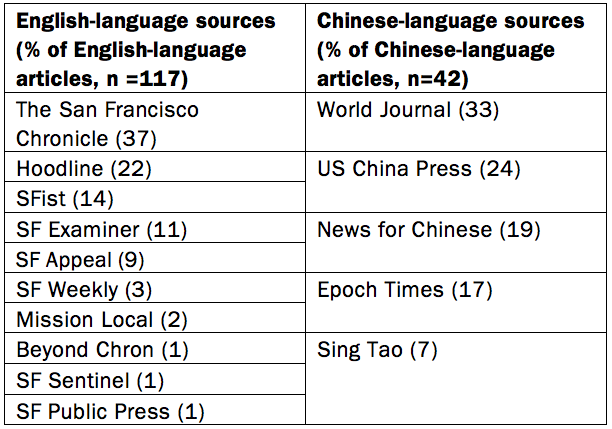
Next, we next eliminated duplicate articles, as well as articles that were not substantively about traffic safety or related issues. Irrelevant articles were usually about general road construction or traffic issues (such as the construction of a new bridge), or focused on traffic collisions or initiatives outside of San Francisco. Our final sample included 117 relevant articles in English and 42 in Cantonese.
Relevant articles appeared throughout the year (see Figure 1), with a slight spike in coverage in November and a decline in December (a month when, historically, journalists tend to focus on specific, holiday-related stories). The largest source of coverage overall was the San Francisco Chronicle (37% of all articles), the city’s main newspaper.
Opinion coverage, including letters to the editor, op-eds, blogs and editorials, can signal community interest about an issue and send a message to policymakers. But opinion articles were relatively infrequent in English-language coverage (20% of English-language stories) and entirely absent from Chinese-language coverage. The majority of opinion pieces in the coverage were letters to the editor in the Chronicle.
Figure 1: English and Cantonese articles published in 2015 about traffic safety in San Francisco, by month (n=159 articles)
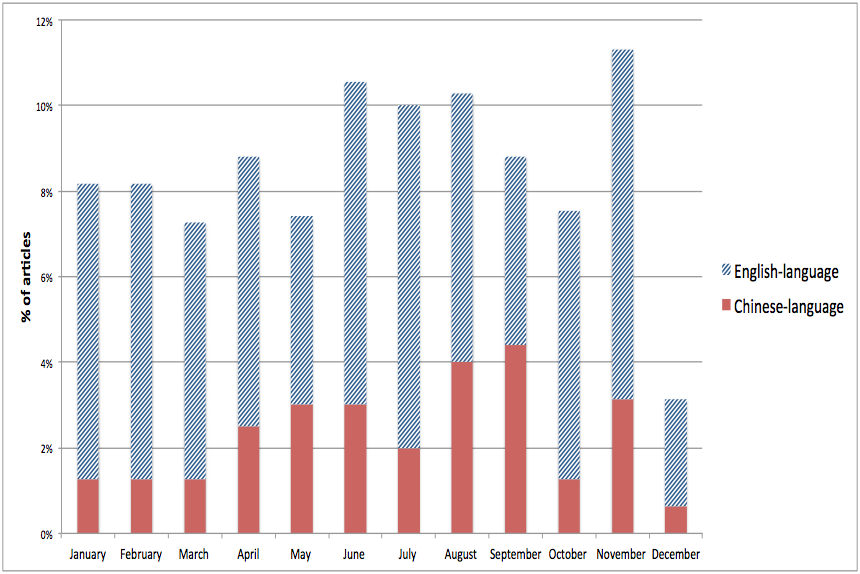
Who speaks in the news about traffic safety?
The presence or absence of different speakers in news coverage signals whose perspectives on the issue are viewed as valid — and whose aren’t. Typically, in stories related to violence or crime, the police and other criminal justice representatives dominate the coverage. We found that this pattern held true in English, but not in Cantonese, coverage of traffic safety issues. San Francisco Police Department (SFPD) representatives were the most common speakers in English coverage, appearing in 32% of articles (see Figure 2). The police also appeared regularly in the Chinese press (40% of articles), but other representatives of city government were even more prominent, appearing in 48% of Chinese-language articles. Among the government speakers who appeared most often in the Chinese press were San Francisco Supervisors Katy Tang and Aaron Peskin, San Francisco mayor Ed Lee, and California State Senate hopeful Scott Weiner.
There were also notable differences between English and Chinese news in the prominence of transportation safety advocates, as well as representatives of community-based organizations focused on issues unrelated to transportation. Transportation safety advocates, such as Nicole Ferrara of Walk SF and Chris Cassidy of the San Francisco Bicycle Coalition, were the second most common set of speakers in English news (in 29% of articles), but seldom appeared in the Chinese press (7% of articles). Conversely, representatives of prominent community-based organizations whose work is unrelated to transportation (like the Chinese Community Development Center or the Mission Economic Development Association) appeared in almost 15% of Cantonese articles, but in just 3% of English-language stories.
Figure 2: Speakers in English and Cantonese news about road safety in San Francisco (n=159 articles)
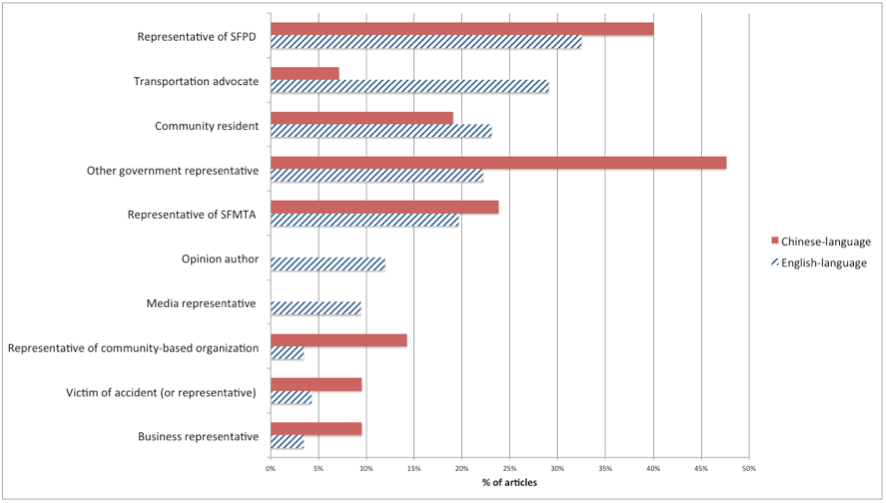
SFMTA representatives and community residents appeared regularly in both English- and Chinese-language news: SFMTA stakeholders appeared in 20% of English and 24% of Chinese stories, while community residents spoke in 23% of English and 19% of Chinese articles.
Typically in news stories, journalists will find a person through whom to tell a story in hopes that readers will connect emotionally. To our surprise, victims of collisions, their families and the medical personnel who treat them were largely absent from the English and Chinese coverage. Collision victims (or their representatives) and medical personnel appeared in 1 in 10 articles from the Chinese press but in only 4% of English-language stories. Medical personnel were entirely absent from the Chinese coverage and appeared in only 4% of English-language stories.
Why were stories in the news?
When traffic or pedestrian safety is covered in the news, why? Why that story, and why that day? Reporters commonly refer to the catalyst for a story as a “news hook.” Many factors can influence why reporters and editors select some stories and not others, from the details of a specific collision to what else competes for attention during the news cycle. We identified the news hook for each article by answering the question, why was this article published today? (See Table 2)
Table 2: News hooks for English and Cantonese news about road safety in San Francisco
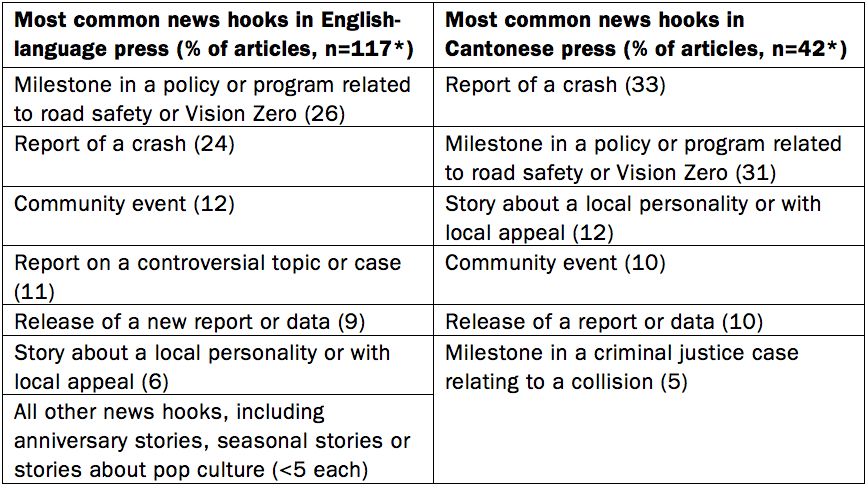
*Categories are mutually exclusive of one another.
Stories most often appeared in English-language news because of a new development in a policy, program or initiative (26% of English-language stories). Among the most controversial policies in the news was the “Idaho Stop” ruling proposed by the Board of Supervisors: the proposal, which was ultimately vetoed, would have allowed bicyclists to treat stop signs as yield signs. During 2015, as this policy made its way through various levels of city government, it generated increasingly heated debate, as when one letter writer accused the Board of Supervisors of “reduc[ing] pedestrian safety to improve convenience for cyclists.”18
Collisions were the second most common news hook for English-language news (24% of articles), followed by community events (12%), such as the mayor’s annual holiday walk through Chinatown (during which pedestrian safety was a key topic)19 or the unveiling of a bicycle and pedestrian corridor.20 Articles also occasionally appeared in the news because of controversies (mostly heated local reactions to the Idaho Stop proposal); because new data had been released; or because of an event (like an election) of particular and specific interest to San Franciscans.
Articles about traffic safety were most often in the Chinese press because a collision had occurred (33% of articles) or because of a new development in a policy or initiative (31% of articles), like a proposal to turn Powell Street into a cable-car-only lane.21 Five percent of stories in the Chinese-language press were in the news because of a milestone in a criminal justice case relating to a collision; we rarely found such stories in English-language news.
How were stories about traffic safety issues framed?
Though many articles in both languages described collisions (54% of Chinese articles and 41% of articles in English), the majority of all articles employed a “landscape” frame (69% of Cantonese and 76% of English-language stories): That is, even if they described a specific collision, the stories tended to include information that helped put the collision into a larger context. For example, statistics about road safety appeared in 45% of Chinese and 47% of English-language articles, and risk factors that could increase the likelihood of a collision appeared in 86% of English articles compared to 38% of Cantonese stories.
How did Vision Zero and transportation equity appear in the news?
Our analysis indicates that the SFMTA has been successful in putting Vision Zero SF on the local news agenda: 31% of English and 26% of Chinese articles mentioned the initiative. In the English press, moreover, discussions of Vision Zero were at times quite extensive: A prominent op-ed from the head of the SFMTA, for example, described the program in depth and concluded, “[Vision Zero] is admittedly ambitious but this is a goal that is achievable, makes sense, and — above all — is the right thing to do.”22 In-depth discussion of Vision Zero was less common in the Chinese-language press, where it was usually mentioned in passing as part of a larger discussion of a solution like an education campaign23 or Automated Speed Enforcement measures.24
Though Vision Zero is part of the news conversation, transportation equity (the right to safe mobility for everyone), a fundamental tenet of Vision Zero, is largely invisible. Only five articles from the English-language press explicitly referenced disparities in traffic injuries and fatalities relating to age,22, 25 race or ethnicity,22 or language background.26
How did the news characterize solutions and why they matter?
To end traffic injury and death, San Francisco will have to put solutions, including Vision Zero solutions, on the public’s and policymakers’ agendas. To determine if news coverage addressed solutions, we identified all references to solutions that appeared in the coverage, including solutions that fell within the Vision Zero framework of enforcement, engineering and education.
Calls for or references to solutions appeared more often in English-language than in Cantonese news (71% of English-language articles compared to 42% of Chinese). In both sets of articles, engineering solutions dominated the coverage. The most commonly described solutions included improvements to roadways or equipment: Almost half of English articles and 1 in 5 Chinese articles described approaches like decreasing the number of vehicle lanes and making sidewalks wider27; extending dedicated transit lanes28; increasing senior zones29; or updating signage and lighting.20 Chinese and English-language news also regularly included discussion of enforcement of a range of traffic violations (25% of English stories and 12% of Chinese), including, notably, enforcement of the controversial “Idaho Stop” policy.
Education to promote behavior change, the third of the “three Es” of Vision Zero, seldom appeared in the news. When educational strategies did appear, they were usually framed as recommendations for individual drivers, pedestrians or bicyclists, rather than coordinated educational campaigns. A typical example came from a San Francisco Police Department representative who admonished bicyclists, “Don’t try to pass a bus. Especially in the streetcar lane. Stay to the right.”30
We wanted to know how, if at all, speakers in the news framed the arguments for and against different solutions. We found that 43% of English and 50% of Cantonese articles described or referenced public safety as a rationale (see Figure 3). An article in World Journal, for example, described one potential solution as a “wise policy” because of its potential to “increase pedestrian and vehicle safety at crosswalks.”31
Figure 3: Arguments for traffic solutions in English- and Chinese-language coverage: “This solution . . .”
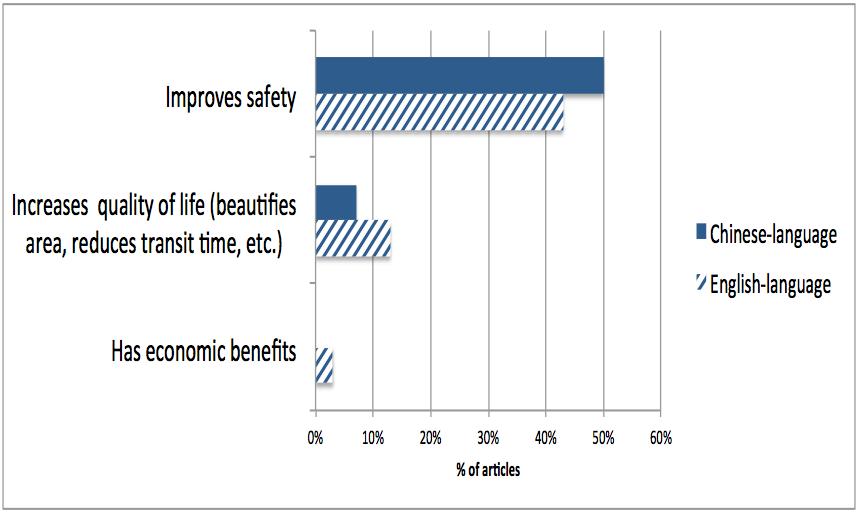
Figure 4: Arguments against traffic solutions in English- and Chinese-language coverage: “This solution . . .”
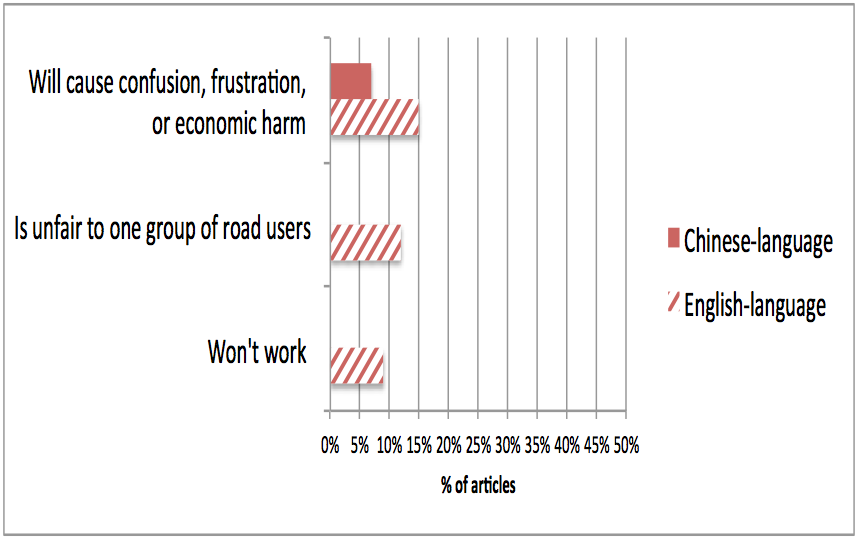
Speakers rarely took to the news to argue against traffic initiatives (see Figure 4). Indeed, arguments opposing traffic initiatives appeared in only 23% of English-language and 7% of Chinese articles. When they appeared, the majority of oppositional arguments focused on how road users would react, as when one San Francisco Supervisor predicted that “eliminating a traffic lane … would provoke instant outrage from motorists.”19
Framing traffic safety: Culpability and accountability
Any debate about ending traffic-related death and injury is rooted in fundamental questions about responsibility, namely: Who is responsible for solving this problem? The majority of both Cantonese and English-language articles contained some type of responsibility language (64% of Chinese and 52% of English stories). In general, responsibility rhetoric in the news included calls upon “the city” in general, or SFMTA in particular, to protect and promote safety, as in, “[T]he Chinese community has urged the SFMTA and the city to make infrastructure improvements immediately,”32 or assertions from the SFMTA and other city representatives that they were taking responsibility for the problem (40% of all articles). A characteristic statement from the SFMTA following the death of a cyclist affirmed the organization’s own accountability: “We are committed to working with our partners to make San Francisco streets safer, while educating the public on traffic safety, enforcement of traffic laws, and prioritizing the necessary resources that implement life-saving initiatives.”30
But at times, responsibility in the news was less a matter of affirming or implying accountability than of assigning blame. Drivers were blamed for causing collisions in 14% of Chinese and 17% of English articles. Sometimes, these assertions of culpability were framed in the context of a police report: For example, the SFPD was quoted in the Epoch Times as assigning an SUV “full responsibility” for a collision with a tour bus.33 At other times, speakers blamed drivers using stronger terms, as in an article that held that a well-known San Francisco cop’s car “plowed into two pedestrians” during a collision in North Beach.34
Less frequently, pedestrians or bicyclists were blamed for causing collisions (5% of Cantonese and 9% of English articles). When they were, they were usually described as sharing responsibility with drivers, as when a San Francisco Chronicle columnist quoted SFPD Commander Mikail Ali as condemning “really, really bad behavior,” and concluded “the behavior — by drivers, bicyclists and pedestrians alike — is often downright shocking.”35
Framing traffic safety: Us against them
The assertions of blame that regularly appear in news coverage are reflective of a larger sense of frustration and division that pervades the news about traffic safety and Vision Zero. Indeed, traffic in San Francisco emerges as a “war,” with every road user out for him or herself.
This divisive frame emerged in a host of ways. For example, we saw rare but powerful instances of language that characterized traffic as a “conflict,” filled with “victims” and “perpetrators” (6% of English-language and 12% of Cantonese articles). We also saw much accusatory language that implicitly or explicitly placed blame for collisions on different street users, like “pedestrians [who] leave the curb with two or three ticks left on the clock … [and] cyclists and drivers [who] watch the clock when they approach the intersection on a green or yellow light and stomp on the gas to try to get through before time is up.”36
Divisions and blame were further reinforced by calls for policies that target one particular type of road user, as when the SF Bicycle Coalition argued that “the San Francisco Police Department should focus enforcement on autos, as they’re the source of the most dangerous collisions.”37 The frustration and isolation felt by drivers in particular sometimes came to a boiling point, as when a taxi driver quoted in the Chinese press argued, “It is extremely difficult to survive in the city as a taxi driver. Downtown San Francisco traffic is terrible, and speeding is acceptable in certain situations.”24
A rare attempt to counter the divisive war frame came from SFMTA’s John Knox White, who pointed out “almost nobody exclusively uses one mode of transportation, so there’s no point in dividing people into camps of cyclists, pedestrians and drivers.”26 But such invocations of shared responsibility and collective action were overshadowed by fiery and divisive language, particularly about the Idaho Stop law, which stirred up considerable tension between road users. Bicyclists, for example, protested that “crackdowns”38 to enforce the proposal were “unfair and unjust,”39 while a typical counterargument from a Chronicle columnist claimed the law was needed because of the actions of “psycho-bikers, the ones who roar through intersections, barely missing pedestrians, challenging cars and generally behaving like morons.”40
In light of such heated rhetoric, it is perhaps not surprising that many articles evoked fear and danger for street users, particularly in the English-language press. Indeed, 1 in 5 English-language articles framed the city streets as dangerous, as when an article from the SF Appeal characterized 2013 as “one of the deadliest years,”41 or a writer from SFist bemoaned a “terrifying” video highlighting “the dangers faced everyday by pedestrians on the streets of San Francisco.”42 By contrast, although Chinese-language articles occasionally made reference to “dangerous” intersections,43, 44 language that evoked fear appeared far less frequently in the Cantonese press (10% of articles).
Conclusions and next steps
Building awareness of and support for Vision Zero SF is a complex multipart process. Our initial analysis of the public narrative around traffic safety issues as they appear in news coverage uncovered a number of challenges and opportunities with important implications for eliminating death and injury on our roads.
Specifically, we found that:
- Although the volume of coverage is not high, traffic safety issues do appear consistently in English and Cantonese news in San Francisco but are largely absent from Spanish-language print media.
- A range of different stakeholders, most of them representatives of different government agencies, dominate the narrative around road safety in English and Chinese, though transportation advocates are a much larger presence in the English-language narrative.
- Vision Zero itself is a key part of the discourse, though there may exist untapped opportunities to deepen the conversation around what it is and why it matters, especially in the Chinese press.
- The Vision Zero solutions framework emerges as a key part of the discourse about traffic safety in San Francisco.
- Transportation equity, a fundamental tenet of Vision Zero, is largely absent from the discourse.
- Division and (in English-language news) danger are key frames that drive and shape the public narrative around traffic safety in San Francisco.
Our findings suggest a host of follow-up questions, such as: Which messengers might be most effective in different communities? For different policymakers? What are the implications of the “traffic as war” frame for building a citywide movement that requires collective action? Are there opportunities to foster a discourse that evokes hope and optimism around traffic safety in San Francisco? What will it take to build a public narrative around safe mobility for all?
Exploring the answers to these and other questions is central to elevating Vision Zero SF and, ultimately, to changing the discourse, advancing improvements for safety, and paving the way toward a city where safety and equity are the rules of the road.
Acknowledgments
This report was written by Pamela Mejia, MS, MPH. Thanks to current and past colleagues at Berkeley Media Studies Group for their research and writing support. Thanks especially to Lillian Seklir, Laura Nixon and Elizabeth Arbatman, who helped code the sample.
This work would not have been possible without the support of the San Francisco Municipal Transportation Authority. In particular, we thank John Knox White for his guidance and insight. Thanks also to the staff of MIG and specifically to Deanna Chow Trotter for her project management. We thank Deborah Oh and Coffee Yan at InterEthnica for their research support, and Leah Shahum and Zach Vanderkooy of the Vision Zero Network for their thoughtful contributions.
© Berkeley Media Studies Group, a project of the Public Health Institute, 2017
References
To view references, please download the pdf version of the report. References begin on Page 16.




